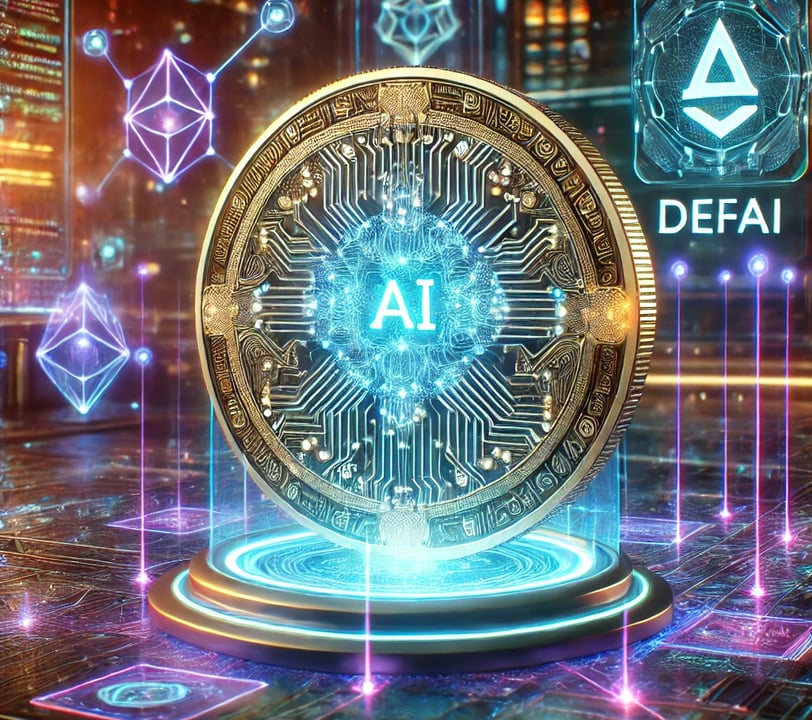DeFAI: The New Narrative in the Cryptocurrency Market
CRYPTO MARKET
1/17/20253 min read


In recent years, the cryptocurrency universe has undergone a continuous revolution, with innovations that challenge traditional paradigms in finance and technology. One such innovation is the emergence of DeFAI (Decentralized Finance Artificial Intelligence), which integrates decentralized finance (DeFi) with artificial intelligence (AI). This article explores the DeFAI narrative, its value proposition, challenges, and how it might shape the future of the crypto market.
What is DeFAI?
DeFAI is the convergence of DeFi and AI. DeFi refers to an ecosystem of financial applications operating on public blockchains, eliminating intermediaries like banks and brokers. AI, on the other hand, involves systems that can simulate human cognitive processes, such as learning, decision-making, and forecasting. DeFAI combines these two powerful technologies to create smarter, more efficient, and more accessible financial solutions.
In the DeFAI context, AI is used to enhance the efficiency of decentralized financial operations, predict market movements, manage risks, and personalize user experiences. By integrating AI into DeFi protocols, DeFAI has the potential to profoundly transform how people interact with financial products.
Key Features of DeFAI
Intelligent Automation: AI enables the creation of more sophisticated smart contracts that can dynamically adapt to market conditions or user behavior. This facilitates safer and more optimized financial operations.
Market Predictions: AI models can analyze large volumes of real-time data to forecast price fluctuations and identify investment opportunities. This is especially useful in volatile markets like cryptocurrencies.
Risk Management: DeFAI can provide detailed risk analyses, helping investors and protocols make more informed decisions. AI can monitor systemic risks and suggest real-time mitigation strategies.
Product Personalization: By leveraging AI, protocols can offer highly personalized experiences, tailoring financial products to users' preferences and behaviors.
Enhanced User Experience: AI-driven interfaces make interactions with DeFi platforms more intuitive, even for inexperienced users.
Use Cases of DeFAI
Automated and Intelligent Trading
Integrating AI algorithms with DeFi platforms enables automated trading based on predictive analytics. AI-equipped bots can identify market patterns and execute orders with greater precision, increasing efficiency and reducing human errors.
Portfolio Management
DeFAI protocols offer portfolio management solutions that use AI to automatically rebalance assets based on market conditions. Additionally, personalized recommendations help investors achieve their financial goals more effectively.
Decentralized Lending and Borrowing
AI can assess borrowers' creditworthiness using on-chain and off-chain data, enabling fairer and more accurate credit issuance. This is particularly relevant for individuals without traditional banking histories.
Security and Compliance
DeFAI is also used to identify suspicious behaviors and prevent fraud in real-time. AI systems can monitor transactions to ensure regulatory compliance and protect assets from malicious attacks.
Challenges of DeFAI
Despite its vast potential, DeFAI faces several challenges that need to be addressed for widespread adoption:
Technological Complexity: Integrating AI and DeFi requires advancements in both fields. Developers must overcome scalability, interoperability, and AI model training challenges.
Data Privacy: AI relies on large volumes of data. Ensuring the privacy and security of this information is crucial to prevent misuse and preserve decentralization.
Regulatory Risks: Regulations around cryptocurrencies and AI are constantly evolving. Regulatory uncertainty can create barriers to developing and adopting DeFAI solutions.
AI Model Reliability: AI models are not perfect and may make incorrect or biased decisions. This is particularly problematic in financial applications, where errors can lead to significant losses.
Market Adoption: Many users still view DeFi technologies as complex. Making DeFAI solutions more accessible will be critical to expanding their user base.
The Future of DeFAI
DeFAI is just beginning to gain traction, but its promising applications suggest it could redefine the financial sector. Some trends likely to shape DeFAI's future include:
Greater Cross-Sector Collaboration: Technology companies, financial institutions, and crypto startups will need to work together to create standards that facilitate the integration of AI and DeFi.
More Accessible Protocols: Simple, educational interfaces combined with AI-based solutions will make the user experience more friendly.
Increased Use of Off-Chain Data: Integrating external data will allow AI models to make more accurate analyses and recommendations.
Clearer Regulations: Over time, regulatory bodies are expected to establish specific guidelines for DeFAI technologies, reducing uncertainty and encouraging innovation.
DeFAI represents a significant evolution in the world of cryptocurrencies and decentralized finance. By combining the advantages of artificial intelligence with the efficiency of decentralized systems, it promises to transform how we manage money, investments, and financial services.
However, like any new technology, DeFAI faces challenges that must be addressed to achieve widespread adoption. Despite this, its combination of innovation, efficiency, and accessibility positions it as one of the leading narratives in the crypto market's future. This is an exciting time for investors, developers, and enthusiasts who wish to be part of this revolution.
